| Pages:
1
2 |
allthesound
Oud Admirer

Posts: 7
Registered: 7-30-2012
Member Is Offline
|
|
Is this Oud worth repairing?
Hi , I bought a old Oud this past spring and it needs allot of help i don't play but found it a interesting instrument. I'm just wondering if its a
worthy candidate for restoration. I know very little about it other than it was made in Syria around 1922. Any advise is appreciated.
Here are some pics.


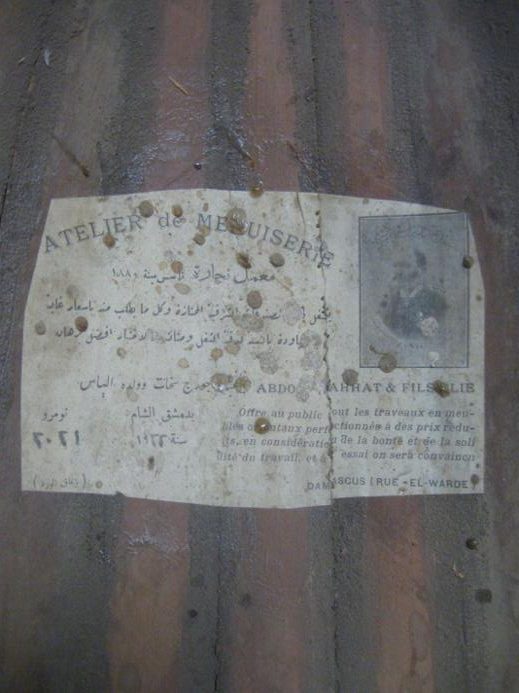
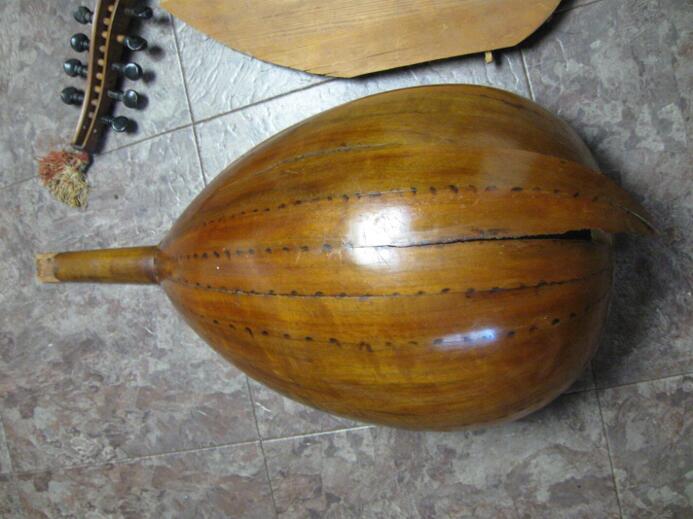
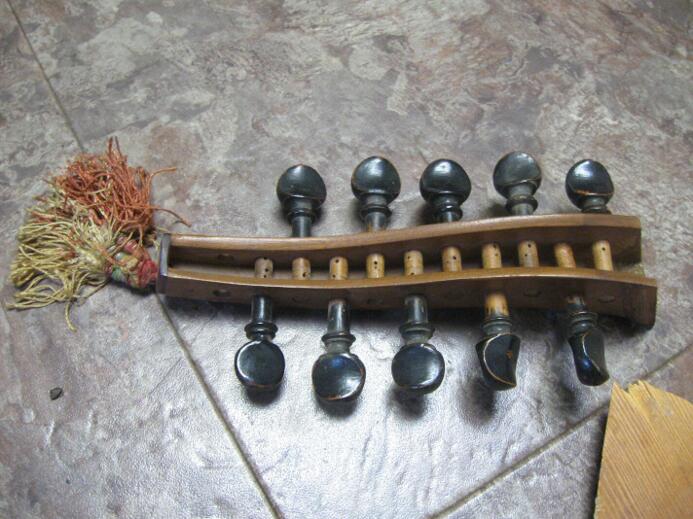
|
|
|
fernandraynaud
Oud Junkie
    
Posts: 1865
Registered: 7-25-2009
Location: San Francisco, California
Member Is Offline
Mood: m'Oudy
|
|
Welcome Althesound! If this baby is what the label says, it would be worth repairing if it were in 100 pieces. It's a bit like finding a Stradivarius.
There are people here who will be able to tell how likely it is that it's genuine. Congratulations!
|
|
|
Faladel
Oud Junkie
    
Posts: 339
Registered: 6-12-2004
Location: Spain
Member Is Offline
Mood: ya salam
|
|
This oud is Made by Abdo Nahat in 1922 , save it , it is very important.
Oud Player
|
|
|
FastForward
Oud Junkie
    
Posts: 225
Registered: 6-2-2008
Member Is Offline
Mood: No Mood
|
|
Can you post a picture, or pictures of the other side of the soundboard, perhaps with a ruler near by.
That would be greatly appreciated.
|
|
|
Microber
Oud Junkie
    
Posts: 853
Registered: 1-20-2006
Location: Belgium - Liège
Member Is Offline
Mood: No Mood
|
|
Even broken, it is nice !
|
|
|
allthesound
Oud Admirer

Posts: 7
Registered: 7-30-2012
Member Is Offline
|
|
Thank you for the reply's . here are a few more shots of the sound board. There are pieces missing as you can see . it would be great if the
soundboard can be saved.
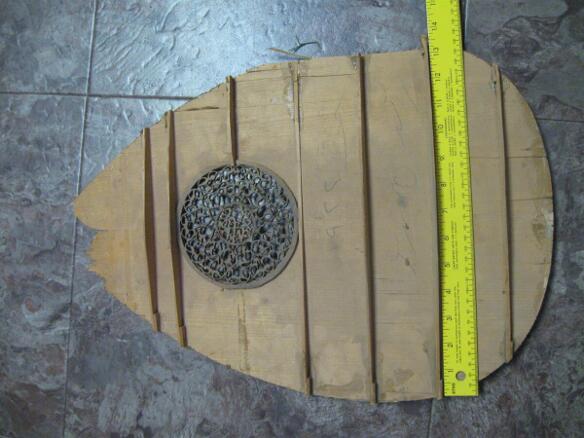

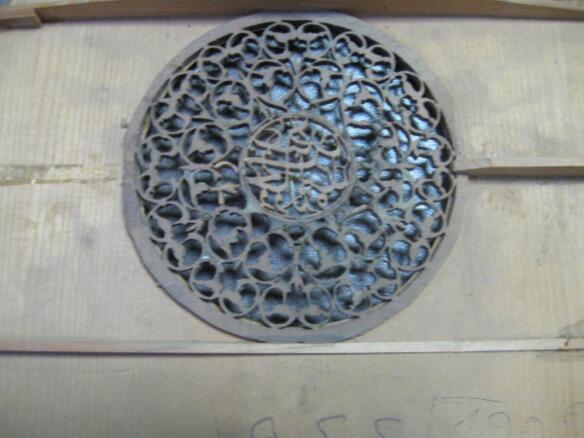
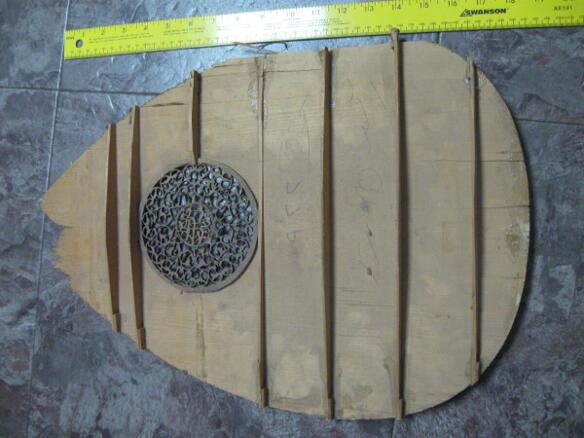
|
|
|
Brian Prunka
Oud Junkie
    
Posts: 2945
Registered: 1-30-2004
Location: Brooklyn, NY
Member Is Offline
Mood: Stringish
|
|
That certainly appears to be authentic, great find. Absolutely worth repairing; it is important that you work with a luthier familiar with Nahat ouds
who can restore it to its maximum potential.
|
|
|
Alfaraby
Oud Junkie
    
Posts: 796
Registered: 9-18-2009
Location: Holy Land
Member Is Offline
Mood: Cool
|
|
As much as photos can tell, this is surely Abdo Nahat & his son Elias from 1922. It's clearly written both on the label & in the rosette. The
label is the famous Abdo's, however it's the first time I see one stating Elias's name. We were familiar with Abdo George Nahat or Abdo George Nahat
& Sons. It's also worth to remark that Abdo never used any other label than this famous one, after Nahat Bro. partnership was liquidated back in
the 1910's. By the way, not a single word in the label about ouds, just a carpentry !
As was stated before discussing the serial number of Abdo:
"the serial numbers stayed consistent and consecutive over the years, whether the rosettes were signed Abdu Only, Abdu & sons then Abdu &
Elias.
#2161 in 1924 - #2333 in 1927 - #2395 in 1928 - #2500 in 1929"
This oud's serial number may fit in: 2021 in 1922.
It seems a small oud, not the big mold of Abdo's, aka masculine cut. Though not very accurate measurements but it seems 49/34 cm mold, aka Istanbulic,
insinuating it looks like the Turkish ouds.
The rosette seems original & well preserved, indicating it's "Abdo Nahat & His Son Elias" affixed by the Nahat famous assembly. Look
at the short brace riding on top of the rose.
The pegbox is a typical Nahat, well preserved in a very good condition, though I can't tell whether some of the pegs might have been replaced through
the years.
The pickguard does not look like any Nahat & it seems it has been replaced. On the other hand, the bridge seems very genuine Nahat.
One of the most typical Nahat work in the interior is carving the neckblock. It's marvelous to see this wonderful work. Look at the neckblock
exceeding to the bowl ribs. What a great job, uncle Abdo ! Although it's not clear from the photos, the tailblock is carved as well.
The bowl is made of ancient Syrian walnut, though I couldn't figure out what are these marks on top of the ribs.
I'd like to see the rosette in a 90 ْ angel closeup & the tailblock as well, if you please !
Now, who would do the job ?
Yours indeed
Alfaraby
alfarabymusic@gmail.com
|
|
|
allthesound
Oud Admirer

Posts: 7
Registered: 7-30-2012
Member Is Offline
|
|
Many thanks guys for all the great info i had no idea what the label said , this is fascinating info! I have taken a few more shots as requested by
Alfaraby . what could i expect to pay for a full restoration just a rough idea to give me a starting point, I understand there are too many variables
to know with certainty but im curious if the would the price of restore exceed the value of the instrument?
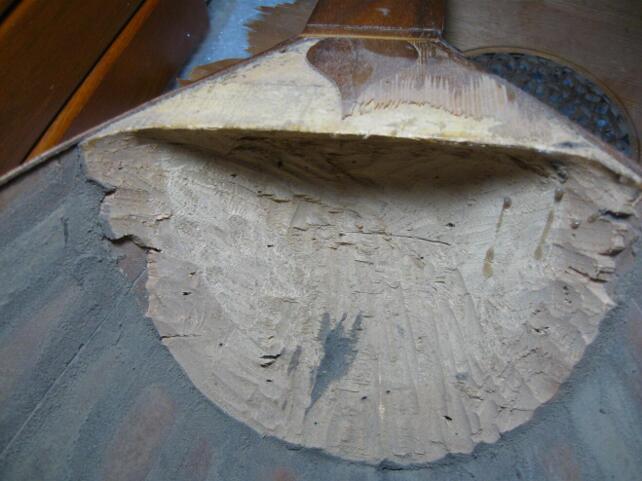
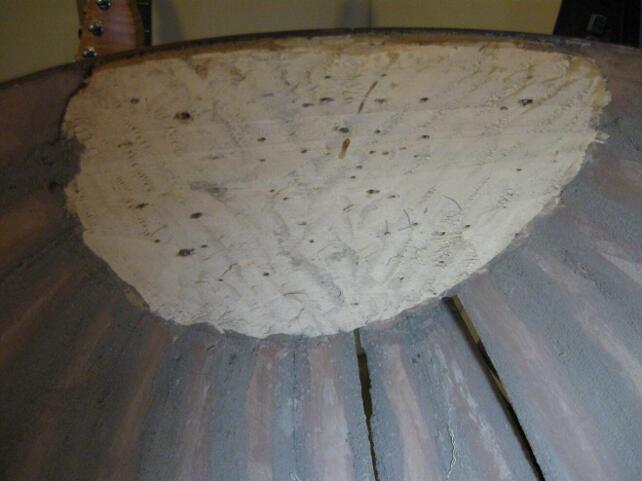

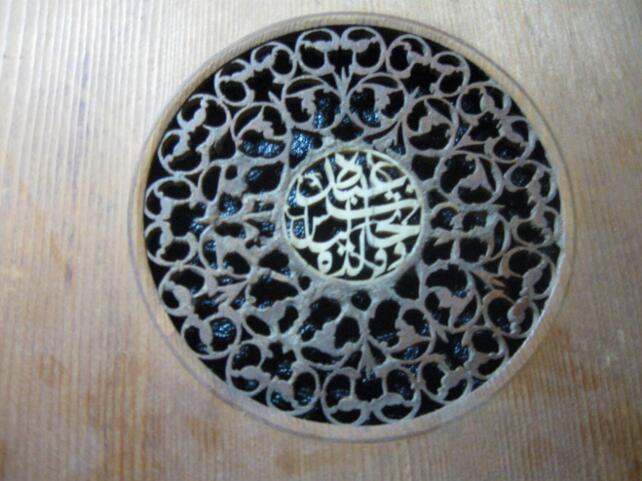
|
|
|
Brian Prunka
Oud Junkie
    
Posts: 2945
Registered: 1-30-2004
Location: Brooklyn, NY
Member Is Offline
Mood: Stringish
|
|
If the restoration is able to preserve the soundboard, and otherwise preserve as much of the instrument as possible, then the value would be somewhere
between $5000 and $9000 as a rough guess.
Ouds like this are getting rarer and rarer so it can be difficult to predict the price. It is possible that it could sell for even more than that.
The final determination of the value would be dependent on the sound of the instrument.
Regardless, the cost of restoration is unlikely to exceed the value of the restored instrument, as long the restoration is well done (a poor
restoration could permanently diminish the value of the instrument).
Estimating from the pictures, it looks like the scale is about 60cm, so it is a bit smaller oud (Nahats are often 61-63cm).
|
|
|
FastForward
Oud Junkie
    
Posts: 225
Registered: 6-2-2008
Member Is Offline
Mood: No Mood
|
|
Thanks for all photos.
I think the oud is fixable, though it is not a job for your average luthier. The oud seems to have undergone some repairs by someone in the past (at
least the back seems like that).
The back needs some serious intricate work but overall seems fixable.
The person who removed the soundboard did a poor job, he broke the soundboard at the neck block, this can be glued back perhaps without affecting the
repair. he also broke the soundboard from side along with some braces.
The most serious issues with the soundboard is that two braces are broken from the side, and one is broken almost all the way. The missing small brace
next to the rosette is not a big issue. There is also a missing brace next to the neck block. If you have any of the missing pieces then that would
help maintain the authenticity of the instrument.
The peg box is almost fully intact and can be easily reassembled. The neck needs some refinishing and cleaning up of glue prior to gluing the pegbox.
This is a great instrument and good luck getting it back in shape.
Brian: I don't know of any Nahhat ouds whose scale is different from 60.9cm. All of the ones I have seen so far have been 60.9 with a body length of
49cm. the width varied between 34.5 and 36. Perhaps Jameel (Alfaraby) can shed more light on this.
|
|
|
jdowning
Oud Junkie
    
Posts: 3485
Registered: 8-2-2006
Location: Ontario, Canada
Member Is Offline
Mood: No Mood
|
|
Although providing some useful detailed information (as intended) it is not possible to determine dimensions or geometry with any degree of precision
from the images posted as they suffer from significant optical distortion having been taken with a camera at close range using a wide angle lens
setting. For example, the image of the sound board showing the bracing layout appears to have been taken with the camera centred over the area of the
bridge but not held perfectly vertical to the sound board surface so that part of the soundboard is seen almost 'face on' (judging from the braces #1
and #2 that appear in head on view but still in perspective view seen from the bass side judging from the floor tile which appears to be wider at the
top than at the bottom). On the other hand the upper part of the sound board is seen in perspective view (again judging from the braces that are seen
in partial side view). Note also that the ruler appears to be bent (due to barrel distortion of the wide angle lens) which will, of course, adversely
affect any measurement of the sound board profile derived from the image as it stands.
So the original string length of the oud might still be 60.9 cm - how does it measure with the sound board temporarily positioned on the bowl?
When taking images of sound boards for the purpose of judging geometry and dimensions they should be taken at a distance with a long focus lens with
the sound board surface and camera focal plane in parallel and well centred to eliminate optical distortion as far as possible. As this is an
important example of an oud, to ensure essential absolute accuracy for historical record purposes, the sound board should be placed face down on a
large sheet of paper and its profile carefully traced with a fine pencil. The dimensions should be accurately recorded with reference to a single
fixed datum point (e.g. bottom of the sound board) and marked up on the drawing to full scale.
I would say from the image posted that the tail block - like the neck block - has been carved as there are gouge chisel marks in evidence and the
inside face follows the exterior contours of the sound board.
I note also that there are string fragments still attached to the bridge. The vintage of these fragments is likely unknown but they should be
carefully preserved and their location on the bridge recorded until they can be subject to future detailed examination.
|
|
|
Microber
Oud Junkie
    
Posts: 853
Registered: 1-20-2006
Location: Belgium - Liège
Member Is Offline
Mood: No Mood
|
|
Could an administrator reduce the pictures for a more confortable reading.
Thanks.

Robert
|
|
|
Brian Prunka
Oud Junkie
    
Posts: 2945
Registered: 1-30-2004
Location: Brooklyn, NY
Member Is Offline
Mood: Stringish
|
|
Quote: Originally posted by FastForward  |
Brian: I don't know of any Nahhat ouds whose scale is different from 60.9cm. All of the ones I have seen so far have been 60.9 with a body length of
49cm. the width varied between 34.5 and 36. Perhaps Jameel (Alfaraby) can shed more light on this.
|
I could be mistaken, but I understood many Nahats to have longer scale lengths, Rabih Abou Khalil has ones that are reportedly 62-63 cm, Najib Shaheen
has one that is 62 cm unless I am remembering incorrectly.
|
|
|
FastForward
Oud Junkie
    
Posts: 225
Registered: 6-2-2008
Member Is Offline
Mood: No Mood
|
|
Brian, I haven't seen many Nahhat oud, probably 5 or 6 in person, and probably twice as many online, they were made by different members of the
Nahhat, none of them was by Abdo. You could be very correct as well, thats why I am hoping someone else can provide us with more info.
|
|
|
Alfaraby
Oud Junkie
    
Posts: 796
Registered: 9-18-2009
Location: Holy Land
Member Is Offline
Mood: Cool
|
|
Thanks a lot FastForward for the credit !
As I have mentioned above, there are two major molds of the Nahat family. I mean the structure not literally. One is the so-called
Masculine cut, meaning it's designated for men (52-3/36 cm), while the other is the so called Istanbulic cut,
meaning it's more like the Turkish ouds (49/34 cm). The third mold, though less common, is the Feminine cut dedicated for women
(47/33 cm +/-). I haven't seen those last ouds in person so the "cm" are only a harsh guess, taking into consideration the second size. We may say
they had Large/Medium/Small sizes.
As to the string length, well, they may vary. The LARGE size could be 61.5 cm long scale up to 63 cm & maybe more, while the MEDIUM could be 60-61
cm or even 61.5 cm long. I've seen some with 61.5 full cm, not 60.9 nor 60 cm. The SMALL size isn't available to have measured it, hoping to meet this
beloved feminine mold soon.
Waiting to see who would do this hard job !
Good luck
Yours indeed
Alfaraby
alfarabymusic@gmail.com
|
|
|
jdowning
Oud Junkie
    
Posts: 3485
Registered: 8-2-2006
Location: Ontario, Canada
Member Is Offline
Mood: No Mood
|
|
That is interesting information about the molds Alfaraby.
Does this mean that there is a consistent single geometry of only three size variants for the bowl and sound board profiles for all ouds produced by
the Nahats during their entire productive period? If so where are the molds - if they do survive - that would allow precise confirmation of the
geometry used in their construction?
The size variants would also seem to be current Turkish oud design practice - girl, woman, boy and man sizes - but shorter string lengths.
The large image size is an irritation - as previously mentioned by Microber. I thought that size restrictions relating to posting images on the Forum
had solved this problem - obviously not.
|
|
|
Alfaraby
Oud Junkie
    
Posts: 796
Registered: 9-18-2009
Location: Holy Land
Member Is Offline
Mood: Cool
|
|
Have the molds been found, an active industry of making replicas would have been developed 
Even without the original molds, a vivid forgery is taking place in Damascus due to the the increasing demand for Nahat's ouds.
I don't have the skill nor the tools to measure the geometry of an oud, but I still think there were more than 3 geometries for 3 types.
Building an oud is not always consistent by the luthier, since he does not always stick to the mold. He would leave space between the mold & the
ribs according to the desired shape he's planning/imagining, a bulge here or there right beyond the neck block, another towards the tail and so forth
!
I have seen some Nahat's that don't really mach any mold I could have seen before, though still looks like one.
Some reliable sources in Damascus have been quoted to say: sometimes it would be the wood that compelled a specific outcome, a short or narrow
soundboard for instance, a short rib ... etc. Wood wasn't always available in fixed measurements like we have nowadays (55/20 cm X 2 soundboards)
& luthiers would make an oud out of what pops up in their workshops and that would be reflected in the final results.
I shall post some photos later on, to show what I really meant. I feel I'm not expressing myself propperly, so the written might sound undue haste !
Excuse me, English is my third language.
Yours indeed
Alfaraby
alfarabymusic@gmail.com
|
|
|
allthesound
Oud Admirer

Posts: 7
Registered: 7-30-2012
Member Is Offline
|
|
Sorry for the huge picture sizes i thought it was odd they displayed as large as they did too. I went ahead and resized them to make reading this
thread a little more comfortable.
Brian i had no idea what the value of this could possibly be i must say im surprised at your estimate i would not have guessed that high. 
Thanks again everyone for all the great responses so far i have learned alot already
Since posting this i have been doing alot of reading on Oud's their history and construction and listening to players on Youtube.
I am really taken with the sound of these instruments and have really enjoyed what i have heard so far.
I agree it is important to preserve this Oud and to keep it as original as possible. After getting some idea of prices It is most likely going to be
beyond my means to send it out and have it done by an expert. So my only option might be to restore it myself. I have alot of research and work ahead
of me if i choose to go that route but i do love a good challenge. 
|
|
|
jdowning
Oud Junkie
    
Posts: 3485
Registered: 8-2-2006
Location: Ontario, Canada
Member Is Offline
Mood: No Mood
|
|
Allthesound - the images are still a bit too large for comfortable viewing of the text - easily corrected by editing the images to a smaller scale
although I am surprised that the automatic Forum restrictions on image size have allowed these oversize images in the first place.
If you have no extensive luthier experience do not attempt restoration of this oud. Practice modern museum conservation philosophy - don't touch it or
try to make any improvements or repairs that might destroy essential evidence for future researchers into the oud or specifically the Nahat
instruments - put it on one side in a safe place as an investment for the future.
Alfaraby - if the molds do not now exist, where is the source that confirms they once did in these three basic sizes? The assertion that the Nahat
luthiers used molds is important enough information in itself which suggests that they all worked to a fixed geometry (albeit with a manufacturing
tolerance) and so did not work in a free hand fashion without a mold as some oud luthiers do today.
Do we in fact know how the Nahat luthiers operated. Did they employ workers to make the various components and just supervised assembly work - all in
the interests of production efficiency and output - or was theirs entirely an exclusive 'hands on' operation covering every aspect of the
manufacturing process?
I suspect that one problem in trying to get down to the root of the Nahats oud geometry or geometries is the fear that this information might help
positively determine a real Nahat from a fake one - unwelcome news for those owners who having forked out large sums of money in the belief that their
oud is a genuine Nahat but which may not be.
My belief is that the Nahats and other oud makers of recent history - like the European lute makers before them - created their geometries based upon
traditional proven successful proportions (sometimes regarded as sacred geometry) handed down through generations. I would be very surprised if the
work of the successful master luthiers was ever in any way random - all constrained within an acceptable degree of tolerance and asymmetry.
The tragedy of the oud is that nothing survives prior to the 19th C - or if it does remains hidden and inaccessible - making research into even
relatively recent oud history problematic. So every bit of evidence about the early surviving instruments should be recorded and preserved.
|
|
|
Brian Prunka
Oud Junkie
    
Posts: 2945
Registered: 1-30-2004
Location: Brooklyn, NY
Member Is Offline
Mood: Stringish
|
|
I have been told by sources that the Nahats did in fact hire out some of the work in creating the rosettes and ornamental pieces for their ouds. I do
not know if this information is accurate, and have no way of confirming or disproving this.
|
|
|
allthesound
Oud Admirer

Posts: 7
Registered: 7-30-2012
Member Is Offline
|
|
Thank you jdowning for your advise and concerns I do really appreciate them. I agree that if there is historical significance to something it should
be approached and handled with the proper sensibilities knowledge and skill.
I would not qualify myself as a luthier with extensive experience i have only been at it for a couple years. I have done quite a few repairs and part
fabrications on acoustic & electric guitars.
I just in the past year started building my own hand made guitars something i hope to do alot more of soon. Rest assured i'm not going go charging
at it with a bottle of Titebond in one hand and a Dremel in the other. My journey begins new. 
I have been reading some old threads here and i have to say I am really impressed with the level of knowledge and the commitment to and passion of the
oud here on this forum. I hope you guys don't mind if i try to soak up as much as i can.
There are indeed some early looking string fragments an inch or so long on the bridge i would be happy to send them to you if they would be of use
for your research.
Best regards, Steve
|
|
|
chaldo
Oud Junkie
    
Posts: 295
Registered: 2-13-2005
Member Is Offline
Mood: archaic mood
|
|
Hi Steve, thank so much for the images and for your interest in saving this oud from 1-garbage, 2-botched repair 3-fireplace winter heating, etc...
If I can ask for a favor in my name and for all Mike`s Oud forum members interested in Nahat oud research.. can you please measure the distance
between every brace just like shown in the photo I am attaching. Also some info on the braces, their height and thickness.
Actually I would also call on John to please provide some sort of questionnaire database entry to enter distances, thicknesses and so on..
to make it easy for people to research and for people willing to donate the details of their nahat ouds.
James, this would definitely help answer some questions asked in this thread: Analysis of Nahhat Bracing... and other threads.
thank you again
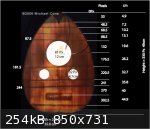
|
|
|
Danielo
Oud Junkie
    
Posts: 365
Registered: 7-17-2008
Location: Paris
Member Is Offline
Mood: No Mood
|
|
Hi John,
the bowl measurements of my Hanna, made in 1921, match exactly those of Alami's George Hanna, built some 30 years later. It's obvious then that George was using the molds left by his father. Btw the
dimensions of this oud do not seem to fit exactly within the 3 categories mentioned by Alfaraby - it is roughly of the 'medium' type but unusually
deep (21.2 cm).
Quote: Originally posted by jdowning  |
Alfaraby - if the molds do not now exist, where is the source that confirms they once did in these three basic sizes? The assertion that the Nahat
luthiers used molds is important enough information in itself which suggests that they all worked to a fixed geometry (albeit with a manufacturing
tolerance) and so did not work in a free hand fashion without a mold as some oud luthiers do today.
|
Steve, congratulations for your discovery and thanks a lot for providing this information the forum 
Where are you located ? I think it would worth showing the instrument to an experienced luthier for advice.
Dan
|
|
|
Alfaraby
Oud Junkie
    
Posts: 796
Registered: 9-18-2009
Location: Holy Land
Member Is Offline
Mood: Cool
|
|
Quote: Originally posted by jdowning  | 1) If the molds do not now exist, where is the source that confirms they once did in these three basic sizes?
2) Do we in fact know how the Nahat luthiers operated ? Did they employ workers to make the various components and just supervised assembly work, or
was theirs entirely an exclusive 'hands on' operation covering every aspect of the manufacturing process?
3) My belief is that the Nahats and other oud makers of recent history created their geometries based upon traditional proven successful proportions
(sometimes regarded as sacred geometry) handed down through generations. |
1) Nahat ouds are the evidence "they once did in these three basic sizes". I have two of these, hoping to find the small size, aka
"Khanum", meaning lady.
2) Ikhwan Nahat (Nahat Bro.) partnership was first established back in 1880 as a carpentry shop specializing in oriental furniture, not ouds. As been
mentioned before, the very same abel of Abdo Nahat, starting in 1910, never mentioned a single word about making ouds ! It pointed out they make
"oriental articles" مصنوعات شرقية. That all. Now, did they have employees in
their workshop ? Well, I think they did. At least Hanna & Antoine used to work in the Nahat Bro. workshop until its liquidation & probably
some other workers & black labor !
3) I agree. One of my friends, who is a mathematician, tried to learn whether the bowl of his Nahat was built according to a foretold geometric
formula or just a random bowl ! He turned to his professor, who examined the bowl thoroughly & found it was built according to a well known
"formula of growing ellipses".
Well, I'm not a mthematician myself, so I couldn't argue this finding. Maybe others can.
Yours indeed
Alfaraby
alfarabymusic@gmail.com
|
|
|
| Pages:
1
2 |